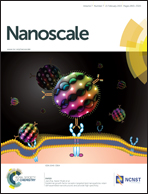Inside the structure of a nanocomposite electrolyte membrane: how hybrid particles get along with the polymer matrix†
Abstract
Hybrid materials remain the target for a fruitful range of investigations, especially for energy devices. A number of hybrid electrolyte membranes consisting of inorganic and organic phases were then synthesized. Mechanical, solvent uptake and ionic transport properties were studied with the key point being the characteristic length scale of the interaction between the phases. A group of nanocomposite membranes made of polystyrenesulfonic acid-grafted silica particles embedded in a Poly(Vinylidene Fluoride-co-HexaFluoroPropene) (PVdF-HFP) matrix was studied by combining neutron and X-ray scatterings on the nanometer to angstrom scale. This approach allows for the variation in the morphology and structure as a function of particle loading to be described. These studies showed that the particles aggregate with increasing particle loading and these aggregates swell, creating a physical interaction with the polymer matrix. Particle loadings lower than 30 wt% induce a slight strain between both of the subphases, namely the polymer matrix and the particles. This strain is decreased with particle loading between 20 and 30 wt% conjointly with the beginning of proton conduction. Then the percolation of the aggregates is the beginning of a significant increase of the conduction without any strain. This new insight can give information on the variation in other important intrinsic properties.


 Please wait while we load your content...
Please wait while we load your content...